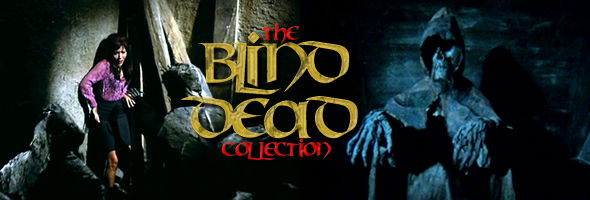
TOMBS OF THE BLIND DEAD
Color, 1971, 97/83m.
Directed by Amando de Ossorio
Starring Lone Fleming, César Burner, María Elena Arpón, Joseph Thelman / WS (1.66:1) (16:9)
RETURN OF THE EVIL DEAD
Color, 1973, 91/87m.
Directed by Amando de Ossorio
Starring Tony Kendall, Fernando Sancho, Esperanza Roy, Lone Fleming, José Canalejas / WS (1.66:1) (16:9)
THE GHOST GALLEON
Color, 1975, 90m. / Directed by Amando de Ossorio / Starring Maria Perschy, Jack Taylor, Bárbara Rey, Carlos Lemos / WS (1.85:1) (16:9)
NIGHT OF THE SEAGULLS
Color, 1976, 89m.
Directed by Amando de Ossorio
Starring Víctor Petit, María Kosti, Sandra Mozarowsky, José Antonio Calvo / WS (1.85:1) (16:9)
Blue Underground (US R0 NTSC)
The biggest name in Spanish horror, the Blind Dead officially rode across screens in four films (with some unofficial related titles along the way like Mansion of the Living Dead) and indoctrinated multiple generations into the joys of Euro horror. Their first appearance came in 1971 with Tombs of the Blind Dead, which you can read about in detail here; that film and its three sequels have been collected in multiple box sets, which are covered here.
Released two years after the original film, El ataque de los muertos sin ojos played fewer territories and was confusingly retitled Return of the Evil Dead for home video, confusing viewers who associated it with the Sam Raimi film. This time the film takes its cue from the American re-edit of the first film and restages the Templars' origin story at the beginning, upping the sadism even 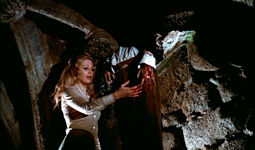 further for a nifty shocker of an opener. In the small town of Bouzano, the villagers prepare to celebrate the fifth century anniversary of the Templars' demise and enlist the aid of outsider Jack Marlowe (Kendall) as a pyrotechnic expert. However, he's less than pleased by the presence of his ex, Vivian (Roy), who's aiding the mayor to organize the event. Meanwhile village idiot Murdo (Canalejas), who's obviously seen a few too many Hammer Dracula films, decides to use one of the local girls to restage one of the Templar sacrifices... with typically disastrous results that put a very bloody damper on the town's festivities. Along the way, Spanish cinema fans will also want to keep their eyes peeled for appearances by Jess Franco character actor Luis Barboo and, more surprisingly, a very young Pedro Almodovar!
further for a nifty shocker of an opener. In the small town of Bouzano, the villagers prepare to celebrate the fifth century anniversary of the Templars' demise and enlist the aid of outsider Jack Marlowe (Kendall) as a pyrotechnic expert. However, he's less than pleased by the presence of his ex, Vivian (Roy), who's aiding the mayor to organize the event. Meanwhile village idiot Murdo (Canalejas), who's obviously seen a few too many Hammer Dracula films, decides to use one of the local girls to restage one of the Templar sacrifices... with typically disastrous results that put a very bloody damper on the town's festivities. Along the way, Spanish cinema fans will also want to keep their eyes peeled for appearances by Jess Franco character actor Luis Barboo and, more surprisingly, a very young Pedro Almodovar!
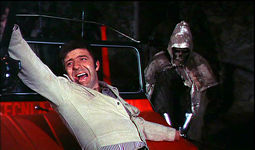 Considerably tightening the pace and wisely setting most of the action at night, Ossorio tweaks and trims much of the Templar history from the first film and enlarges the scale somewhat, staging scenes of mass pandemonium and explicit bloodshed that keep this film fresh and invigorating. Unfortunately the film's English version fell afoul of the censors, losing many of its highlights and suffering drastically as a result (particularly the aforementioned opening and the Templar resurrection, rendered completely ineffectual in most prints). Ossorio also effectively uses handheld camerawork and more ambitious construction of overlapping subplots to spice up the proceedings, with the anniversary celebration plot offering a novel twist later appropriated by John Carpenter's The Fog (which also owes more than a nod to the third Blind Dead film, for obvious reasons).
Considerably tightening the pace and wisely setting most of the action at night, Ossorio tweaks and trims much of the Templar history from the first film and enlarges the scale somewhat, staging scenes of mass pandemonium and explicit bloodshed that keep this film fresh and invigorating. Unfortunately the film's English version fell afoul of the censors, losing many of its highlights and suffering drastically as a result (particularly the aforementioned opening and the Templar resurrection, rendered completely ineffectual in most prints). Ossorio also effectively uses handheld camerawork and more ambitious construction of overlapping subplots to spice up the proceedings, with the anniversary celebration plot offering a novel twist later appropriated by John Carpenter's The Fog (which also owes more than a nod to the third Blind Dead film, for obvious reasons).
And so with film number three, de Ossorio was forced to conjure up a new setting in which to showcase his beloved blind knights. 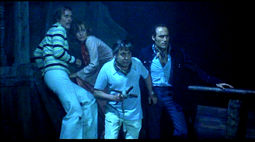 The result was the fog-shrouded nautical horror outing, The Ghost Galleon, shown widely in U.S. drive-ins courtesy of Sam Sherman's Independent International as Horror of the Zombies. Though considerably less gory than the first two films, this entry focuses on atmosphere and suspense with only a few jarring interjections of carnage where appropriate. The film was exhibited in a slightly cut version (often on TV as Ship of Zombies), but overall it never suffered remotely as much as its ancestors. Essentially remaking the first film at sea, the story involves chauvanistic fashion guru Howard (Jess Franco regular Jack Taylor), model Noemi (Rey), and plucky Lillian (Perschy) going to sea in search of two missing fashion models whose promotional outing in a boat brought them in contact with a creepy ghost ship. Of course, the Templars are actually inhabiting the ghostly vessel, which seems to claim the lives of everyone it crosses...
The result was the fog-shrouded nautical horror outing, The Ghost Galleon, shown widely in U.S. drive-ins courtesy of Sam Sherman's Independent International as Horror of the Zombies. Though considerably less gory than the first two films, this entry focuses on atmosphere and suspense with only a few jarring interjections of carnage where appropriate. The film was exhibited in a slightly cut version (often on TV as Ship of Zombies), but overall it never suffered remotely as much as its ancestors. Essentially remaking the first film at sea, the story involves chauvanistic fashion guru Howard (Jess Franco regular Jack Taylor), model Noemi (Rey), and plucky Lillian (Perschy) going to sea in search of two missing fashion models whose promotional outing in a boat brought them in contact with a creepy ghost ship. Of course, the Templars are actually inhabiting the ghostly vessel, which seems to claim the lives of everyone it crosses...
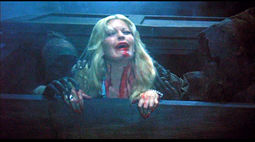 Working with only half of a ship set and limited resources, Ossorio does what he can with the premise and conjures up some nightmarish scenes of misty mayhem aboard the ship. However, the film suffers a bit from the most excessive padding in the series, with characters wandering around and pondering about the proceedings but rarely making any forward strides at all. It's still spooky fun and a worthy entry in the series; significantly, fans tend to each finger a different film in the series as their favorite with this one getting its fair share of votes, so the approach here certainly has its supporters.
Working with only half of a ship set and limited resources, Ossorio does what he can with the premise and conjures up some nightmarish scenes of misty mayhem aboard the ship. However, the film suffers a bit from the most excessive padding in the series, with characters wandering around and pondering about the proceedings but rarely making any forward strides at all. It's still spooky fun and a worthy entry in the series; significantly, fans tend to each finger a different film in the series as their favorite with this one getting its fair share of votes, so the approach here certainly has its supporters.
With its fourth installment, the blind dead rode for the last time in Night of the Seagulls, easily the most underrated film of the quartet. After the typical prologue in which a medieval couple runs afoul of the horse-riding marauders, we meet our modern-day protagonists, Dr. Stein (Petit) and wife Joan (Kosti), whose recent relocation to a small seaside village is met with less than open arms. They're told to never go out at night, and before long the doc is warned to clear out altogether before it's too late. One night a young bloody boy shows up at their doorstop and refuses to go back out into the night, where clusters of seagulls foretell the nocturnal appearance of strange figures assembling along the beach. Before long mutilated victims are turning up on the sand among the crabs and seagulls, indicating the Templars are back in business and ready to coat the sand with blood.
Taking a cue this time from Straw Dogs and an acknowledged debt to H.P. Lovecraft, this film continues the previous entry's emphasis on mood and setting above sex and violence; however, this time de Ossorio finds a more satisfying balance of blood and artistry. The folkloric aspects work especially well here, with the terrorized but hardly moral townspeople making a wonderfully ambiguous environment for the two heroes. This is also the most beautifully shot film in the series, with startling seascapes and evocative nighttime photography revealing the director's increasing confidence behind the camera. Though finally left intact for its English release, this film received the most limited distribution of the entire series and signalled the final death knell for the blind flesheaters (apart from an unofficial softcore cash-in from Jess Franco, Mansion of the Living Dead). De Ossorio would continue in horror with diminishing returns in Night of the Sorcerers, The Lorelei's Grasp, Demon Witch Child, and The Sea Serpent, but at least his most famous series was allowed to exit on a high note.
Not counting a handful of obscure VHS releases, Tombs of the Blind Dead really made its first mass market impression with an Elite laserdisc and Anchor Bay DVD containing the full uncut version, in Spanish with burned-in English subtitles. (The laserdisc also gained a bit of infamy by erroneously dedicating its 1996 release to the "late" director, who remained very much alive until 2001!). Unfortunately the transfer was a bit drab and colorless, with the blood looking far too muddy and brown for its own good. Blue Underground's upgrade wisely contains both the full Spanish cut and the shorter English dubbed version (really a quite different film worthy of preservation), with optional English subtitles for the former version. The Spanish cut looks marvelous, with perfect black levels and much improved color. The shorter English version (apparently culled a generation or two further down) doesn't fare quite as well, with dark scenes tending to go a bit too murky; however, it's still quite watchable and much better than any prior video version. Stick with the pristine Spanish version for maximum impact, however, as it's presented full-strength and avoids the atrocious English dubbing. Extras include the theatrical trailer, a poster and still gallery, and most amazingly, an alternate prologue with new narration prepared for the film's reissue as Revenge of Planet Ape, designed to pass this off as part of Fox's Planet of the Apes series!
Initially released on DVD from Anchor Bay as a flip-side to the first film, Return of the Evil Dead has never appeared complete in any English format until this box set. The restoration is quite welcome and should do wonders for the film's reputation, which has always suffered in comparison. The shorter English cut looks perfect, improving in every respect by leaps and bounds over the prior DVD; the Spanish print with optional subtitles looks grainier and occasionally seems to suffer from color registration flaws (note the occasional red outlines in landscape shots), not to mention a loud audio glitch at the 22-minute mark. Still, it's gratifying to finally see the film uncut in quality many leagues beyond the bootleg market. Extras include the Spanish trailer and a poster/still gallery.
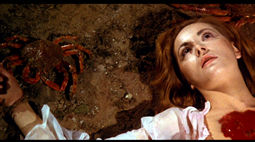 The Templar film most widely available on home video, The Ghost Galleon suffered its most humiliating release as part of the condescending "World's Worst Videos" series back in the '80s and fared only slightly better as part of an unauthorized entry in one of Brentwood's ubiquitous cheapie box sets as Zombie Flesh Eaters (no relation to the Fulci film). The Blue Underground version is obviously the only way to go, as it's completely uncut and looks gorgeous from start to finish. The foggy scenes which could have proved problematic during compression come out clean and clear here; it's unlikely any prints ever looked this good! This time the film is presented full-length with the English and Spanish audio tracks present on the same print, with optional English subtitles. Obviously the Spanish one is far more dignified, but nostalgic fans may still enjoy the very canned English dub on its own terms. Extras this time out include the international Ghost Galleon trailer, the U.S. Horror of the Zombies trailer, the U.S. TV and radio spots, and a poster and still gallery.
The Templar film most widely available on home video, The Ghost Galleon suffered its most humiliating release as part of the condescending "World's Worst Videos" series back in the '80s and fared only slightly better as part of an unauthorized entry in one of Brentwood's ubiquitous cheapie box sets as Zombie Flesh Eaters (no relation to the Fulci film). The Blue Underground version is obviously the only way to go, as it's completely uncut and looks gorgeous from start to finish. The foggy scenes which could have proved problematic during compression come out clean and clear here; it's unlikely any prints ever looked this good! This time the film is presented full-length with the English and Spanish audio tracks present on the same print, with optional English subtitles. Obviously the Spanish one is far more dignified, but nostalgic fans may still enjoy the very canned English dub on its own terms. Extras this time out include the international Ghost Galleon trailer, the U.S. Horror of the Zombies trailer, the U.S. TV and radio spots, and a poster and still gallery.
Released on video often under the title Night of the Death Cult (with a brief bootleg sojourn from Brentwood again on DVD), Night of the Seagulls likewise 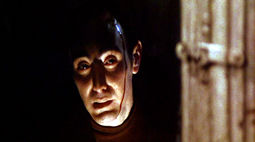 looks quite impressive in this set. The widescreen framing restores the crucial compositions marred on previous releases, which were never cut but suffered in terms of quality. No complaints here as the film looks solid from start to finish, though some of the soft-focus day scenes look a bit gritty as they always have. Again the Spanish and English tracks are presented for the film (with optional English subtitles), with the former coming off clearly as the preferable choice. Also included are the trailer and a poster/still gallery.
looks quite impressive in this set. The widescreen framing restores the crucial compositions marred on previous releases, which were never cut but suffered in terms of quality. No complaints here as the film looks solid from start to finish, though some of the soft-focus day scenes look a bit gritty as they always have. Again the Spanish and English tracks are presented for the film (with optional English subtitles), with the former coming off clearly as the preferable choice. Also included are the trailer and a poster/still gallery.
Also included is a fifth disc, Amando de Ossorio: Director, providing a fascinating overview of the director's career. The biggest feature is "The Last Templar," a Spanish-produced 25-minute documentary in which many particpants (including Jack Taylor and a briefly-seen Paul Naschy) discuss the director's career, complete with choice (but often dupey-looking) clips from many of his films. Interview footage from de Ossorio himself even works its way in near the end. However, you'll see far more of him in an 11-minute interview, "Unearthing the Blind Dead," in which he discusses each of the four films and the various limitations he had to surmount to create what believed would be quality cinema with commercial appeal. 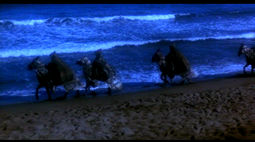 (A note at the beginning warns of poor quality sound, though it's still quite acceptable and better than many featurettes!) Finally, DVD-ROM users can access an overview of his career written shortly after his death.
(A note at the beginning warns of poor quality sound, though it's still quite acceptable and better than many featurettes!) Finally, DVD-ROM users can access an overview of his career written shortly after his death.
The entire lovingly-assembled collection is packaged in a striking black coffin box; unlike the problematic Anchor Bay UK coffin releases, this one wisely retains each disc in its own plastic case with stunning covers culled from the original European poster art. Also enclosed is a thick booklet reprinting Nigel Burrell's Knights of Terror study for Midnight Media, profusely illustrated with lobby cards and other rare visual ephemera. Horror fans, rejoice; the Templars have finally galloped to DVD in high style!



 further for a nifty shocker of an opener. In the small town of Bouzano, the villagers prepare to celebrate the fifth century anniversary of the Templars' demise and enlist the aid of outsider Jack Marlowe (Kendall) as a pyrotechnic expert. However, he's less than pleased by the presence of his ex, Vivian (Roy), who's aiding the mayor to organize the event. Meanwhile village idiot Murdo (Canalejas), who's obviously seen a few too many Hammer Dracula films, decides to use one of the local girls to restage one of the Templar sacrifices... with typically disastrous results that put a very bloody damper on the town's festivities. Along the way, Spanish cinema fans will also want to keep their eyes peeled for appearances by Jess Franco character actor Luis Barboo and, more surprisingly, a very young Pedro Almodovar!
further for a nifty shocker of an opener. In the small town of Bouzano, the villagers prepare to celebrate the fifth century anniversary of the Templars' demise and enlist the aid of outsider Jack Marlowe (Kendall) as a pyrotechnic expert. However, he's less than pleased by the presence of his ex, Vivian (Roy), who's aiding the mayor to organize the event. Meanwhile village idiot Murdo (Canalejas), who's obviously seen a few too many Hammer Dracula films, decides to use one of the local girls to restage one of the Templar sacrifices... with typically disastrous results that put a very bloody damper on the town's festivities. Along the way, Spanish cinema fans will also want to keep their eyes peeled for appearances by Jess Franco character actor Luis Barboo and, more surprisingly, a very young Pedro Almodovar!
 Considerably tightening the pace and wisely setting most of the action at night, Ossorio tweaks and trims much of the Templar history from the first film and enlarges the scale somewhat, staging scenes of mass pandemonium and explicit bloodshed that keep this film fresh and invigorating. Unfortunately the film's English version fell afoul of the censors, losing many of its highlights and suffering drastically as a result (particularly the aforementioned opening and the Templar resurrection, rendered completely ineffectual in most prints). Ossorio also effectively uses handheld camerawork and more ambitious construction of overlapping subplots to spice up the proceedings, with the anniversary celebration plot offering a novel twist later appropriated by John Carpenter's The Fog (which also owes more than a nod to the third Blind Dead film, for obvious reasons).
Considerably tightening the pace and wisely setting most of the action at night, Ossorio tweaks and trims much of the Templar history from the first film and enlarges the scale somewhat, staging scenes of mass pandemonium and explicit bloodshed that keep this film fresh and invigorating. Unfortunately the film's English version fell afoul of the censors, losing many of its highlights and suffering drastically as a result (particularly the aforementioned opening and the Templar resurrection, rendered completely ineffectual in most prints). Ossorio also effectively uses handheld camerawork and more ambitious construction of overlapping subplots to spice up the proceedings, with the anniversary celebration plot offering a novel twist later appropriated by John Carpenter's The Fog (which also owes more than a nod to the third Blind Dead film, for obvious reasons).
 The result was the fog-shrouded nautical horror outing, The Ghost Galleon, shown widely in U.S. drive-ins courtesy of Sam Sherman's Independent International as Horror of the Zombies. Though considerably less gory than the first two films, this entry focuses on atmosphere and suspense with only a few jarring interjections of carnage where appropriate. The film was exhibited in a slightly cut version (often on TV as Ship of Zombies), but overall it never suffered remotely as much as its ancestors. Essentially remaking the first film at sea, the story involves chauvanistic fashion guru Howard (Jess Franco regular Jack Taylor), model Noemi (Rey), and plucky Lillian (Perschy) going to sea in search of two missing fashion models whose promotional outing in a boat brought them in contact with a creepy ghost ship. Of course, the Templars are actually inhabiting the ghostly vessel, which seems to claim the lives of everyone it crosses...
The result was the fog-shrouded nautical horror outing, The Ghost Galleon, shown widely in U.S. drive-ins courtesy of Sam Sherman's Independent International as Horror of the Zombies. Though considerably less gory than the first two films, this entry focuses on atmosphere and suspense with only a few jarring interjections of carnage where appropriate. The film was exhibited in a slightly cut version (often on TV as Ship of Zombies), but overall it never suffered remotely as much as its ancestors. Essentially remaking the first film at sea, the story involves chauvanistic fashion guru Howard (Jess Franco regular Jack Taylor), model Noemi (Rey), and plucky Lillian (Perschy) going to sea in search of two missing fashion models whose promotional outing in a boat brought them in contact with a creepy ghost ship. Of course, the Templars are actually inhabiting the ghostly vessel, which seems to claim the lives of everyone it crosses...
 Working with only half of a ship set and limited resources, Ossorio does what he can with the premise and conjures up some nightmarish scenes of misty mayhem aboard the ship. However, the film suffers a bit from the most excessive padding in the series, with characters wandering around and pondering about the proceedings but rarely making any forward strides at all. It's still spooky fun and a worthy entry in the series; significantly, fans tend to each finger a different film in the series as their favorite with this one getting its fair share of votes, so the approach here certainly has its supporters.
Working with only half of a ship set and limited resources, Ossorio does what he can with the premise and conjures up some nightmarish scenes of misty mayhem aboard the ship. However, the film suffers a bit from the most excessive padding in the series, with characters wandering around and pondering about the proceedings but rarely making any forward strides at all. It's still spooky fun and a worthy entry in the series; significantly, fans tend to each finger a different film in the series as their favorite with this one getting its fair share of votes, so the approach here certainly has its supporters.
 The Templar film most widely available on home video, The Ghost Galleon suffered its most humiliating release as part of the condescending "World's Worst Videos" series back in the '80s and fared only slightly better as part of an unauthorized entry in one of Brentwood's ubiquitous cheapie box sets as Zombie Flesh Eaters (no relation to the Fulci film). The Blue Underground version is obviously the only way to go, as it's completely uncut and looks gorgeous from start to finish. The foggy scenes which could have proved problematic during compression come out clean and clear here; it's unlikely any prints ever looked this good! This time the film is presented full-length with the English and Spanish audio tracks present on the same print, with optional English subtitles. Obviously the Spanish one is far more dignified, but nostalgic fans may still enjoy the very canned English dub on its own terms. Extras this time out include the international Ghost Galleon trailer, the U.S. Horror of the Zombies trailer, the U.S. TV and radio spots, and a poster and still gallery.
The Templar film most widely available on home video, The Ghost Galleon suffered its most humiliating release as part of the condescending "World's Worst Videos" series back in the '80s and fared only slightly better as part of an unauthorized entry in one of Brentwood's ubiquitous cheapie box sets as Zombie Flesh Eaters (no relation to the Fulci film). The Blue Underground version is obviously the only way to go, as it's completely uncut and looks gorgeous from start to finish. The foggy scenes which could have proved problematic during compression come out clean and clear here; it's unlikely any prints ever looked this good! This time the film is presented full-length with the English and Spanish audio tracks present on the same print, with optional English subtitles. Obviously the Spanish one is far more dignified, but nostalgic fans may still enjoy the very canned English dub on its own terms. Extras this time out include the international Ghost Galleon trailer, the U.S. Horror of the Zombies trailer, the U.S. TV and radio spots, and a poster and still gallery.
 looks quite impressive in this set. The widescreen framing restores the crucial compositions marred on previous releases, which were never cut but suffered in terms of quality. No complaints here as the film looks solid from start to finish, though some of the soft-focus day scenes look a bit gritty as they always have. Again the Spanish and English tracks are presented for the film (with optional English subtitles), with the former coming off clearly as the preferable choice. Also included are the trailer and a poster/still gallery.
looks quite impressive in this set. The widescreen framing restores the crucial compositions marred on previous releases, which were never cut but suffered in terms of quality. No complaints here as the film looks solid from start to finish, though some of the soft-focus day scenes look a bit gritty as they always have. Again the Spanish and English tracks are presented for the film (with optional English subtitles), with the former coming off clearly as the preferable choice. Also included are the trailer and a poster/still gallery.
 (A note at the beginning warns of poor quality sound, though it's still quite acceptable and better than many featurettes!) Finally, DVD-ROM users can access an overview of his career written shortly after his death.
(A note at the beginning warns of poor quality sound, though it's still quite acceptable and better than many featurettes!) Finally, DVD-ROM users can access an overview of his career written shortly after his death.